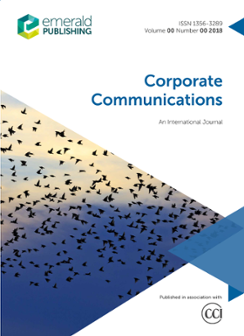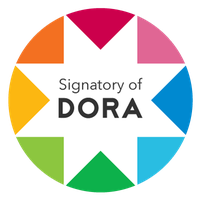Corporate Communications: An International Journal
Issue(s) available: 122 – From Volume: 1 Issue: 1, to Volume: 29 Issue: 7

Volume 29
Volume 28
Volume 26
Volume 25
Volume 24
Volume 23
Volume 22
Volume 20
Volume 19
Volume 18
Volume 17
Volume 15
Volume 14
Volume 13
Volume 12
Volume 11
Challenges of strategic digital communications in local media industries during the COVID-19 pandemic in Serbia, North Macedonia and Bulgaria
Natasa Simeunovic Bajic, Ilija Milosavljevic, Marina Tuneva, Vyara AngelovaThis paper seeks to analyze how local media in Serbia, North Macedonia and Bulgaria have integrated digital technologies and tools into their work and corporate communication…
Silent ripples: negative CSR associations' impact in non-crisis situations
Bitt Moon, Chang-Won Choi, Eugene KimA total of 478 Americans participated in an online survey. Each participant was asked to answer questions about a company randomly assigned from one of 36 companies representing…
Effectiveness of femvertising communications on social media: how brand promises and motive attributions impact brand equity and endorsement outcomes
Christian Rudeloff, Joke BrunsWith the growing importance of conscientious branding, companies are increasingly adopting messages of female empowerment in their social media communications. However, this is…
Empowering public relations for sustainability: examining the landscape in Turkey
Nilüfer GeysiThis paper examines the engagement of public relations (PR) in advancing sustainability within Turkey, exploring both current contributions and future potential. It analyzes how…
Societal impact of Brand Public Relations on gender equality: evidence for a mediation-type mechanism
Michal ChmielThe purpose of the project was to identify a mechanism of causal relationship between Brand Public Relations (BPR) and societal change in the perception of women gender roles.
Board gender diversity and social disclosures: some empirical evidence from Indian companies
Akshita Arora, Kuldeep SinghThe objective of this study is to assess if corporate social disclosures in a company are influenced by gender diversity at board level. We also investigate the number of women…
From greenwashing to greenbleaching: green communication and mitigating moral outrage in the context of revisited situational crisis communication theory
Marko Selaković, Nikolina Ljepava, Noushin Bagheri, Riad Al ChamiThe purpose of the study is to examine the relevance and application of green communication in management of the risks associated with moral outrage inducing crises. The study…
A limit to how much you can plan – planned and improvised strategic communication during COVID-19
Truls Strand OfferdalThis paper investigates the relationship between prior planning and the practical adaptation and improvisation conducted by organizations during the COVID-19 pandemic through a…
Online faith-holder communities in crisis: proposing and testing a dual-challenge model
Ruqin Ren, Bei YanThough current literature has started to recognize the significant role that online faith-holders play in the context of brand reputation crises, extant research lacks a…
Human social responsibility from challenges to achievements: discursive empowerment of women innovators across organizational borders
Carmen Daniela MaierThe paper explains how challenges and achievements of human social responsibility (HSR) are addressed by women innovators across the organizational borders of various industries…
Understanding the efficacy of leadership communication styles in flex work contexts
Renee Mitson, Hao Xu, Jay HmielowskiBecause a large number of employees now work remotely, either completely or partially (e.g. flexible), it is imperative that scholars and practitioners understand the implications…
Exploring business and SDG discourse on X: topics, users and engagement
Christine Ascencio, Randika EramudugodaThis paper examines thematic discourses concerning business and the Sustainable Development Goals (SDGs) on X (formerly Twitter), aiming to uncover active user groups and evaluate…
Enhancing brand loyalty through LGBTQ+ influencers: a study on the impact of firm-generated content in inclusive marketing strategies
Evi Chatzopoulou, Athanasios Poulis, Apostolos GiovanisThis study aims to examine the impact of firm-generated content (FGC) on lesbian, gay, bisexual, transgender, queer/questioning (LGBTQ+) influencers, focussing on inclusive…
Somebody's watching me: boundary turbulence and its impact on employee engagement
Laura L. Lemon, Claudia Bawole, Nancy H. Brinson, Bahareh AminiThe purpose of this paper is to use the concept of boundary turbulence from Communication Privacy Management (CPM) theory to better understand how employee monitoring impacts…
Attitudes toward sustainable development and employer brands: comparing generations X, Y and Z in two countries
Ana Tkalac Verčič, Dejan VerčičThis study investigates how sustainability influences employer branding across generational cohorts – Generations Z, Y and X – and between two neighboring countries, Slovenia and…
Inclusive sponsorship activation and gender equity in sports: the case of orange company
Pascale Marceau, Frank PonsThis study aims to identify the determining factors of perceived altruism and attitude toward an inclusive sponsorship activation, as well as the impact of these variables on the…
Breaking with the seductive promises of internal social media: a critical appraisal
Christiane Marie Høvring, Anne Gammelgaard BallantyneThe purpose of this article is to critically analyze the existing literature on internal social media (ISM) within the context of internal communication, aiming to provide a more…
Fashion industry in crisis: a systematic literature review 1972–2022
Sophie Louise JohnsonThis systematic literature review presents the state of the field of fashion and crisis communication. The quantitative coding offers insight into dominant and emergent themes in…
Helpful or harmful? The impact of gender stereotypes on publics’ crisis response
Sining Kong, Michelle Marie Maresh-Fuehrer, Shane GleasonAlthough situational crisis communication theory (SCCT) is centered on rationality and cognitive information processing, it ignores that people are also driven by irrationality…
Green branding in fast fashion: examining the impact of social sustainability claims on Chinese consumer behaviour and brand perception
Tahira Javed, Ali B. Mahmoud, Jun Yang, Xu ZhaoThis study aims to investigate the ecological awareness of Chinese consumers towards fast fashion and examine the effect of social sustainability claims on green brand image and…
ISSN:
1356-3289Online date, start – end:
1996Copyright Holder:
Emerald Publishing LimitedOpen Access:
hybridEditor:
- Martina Topic
